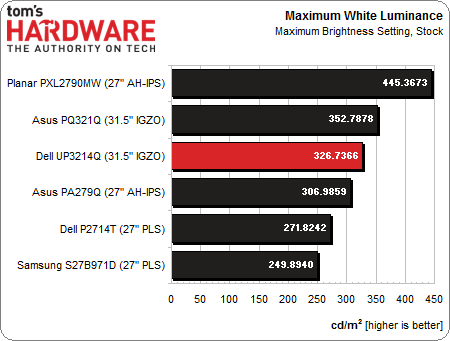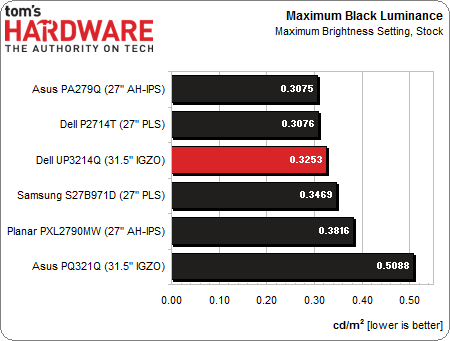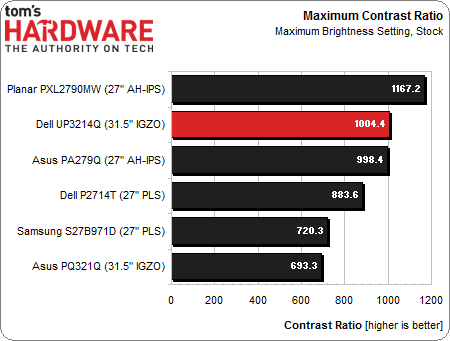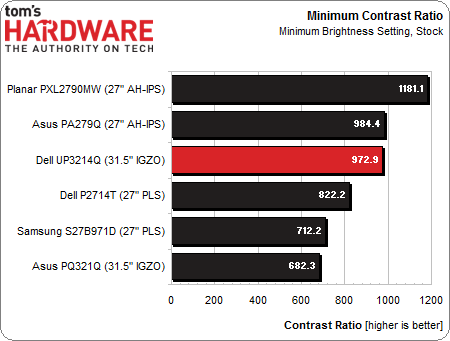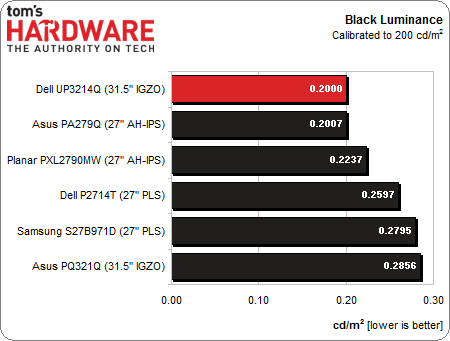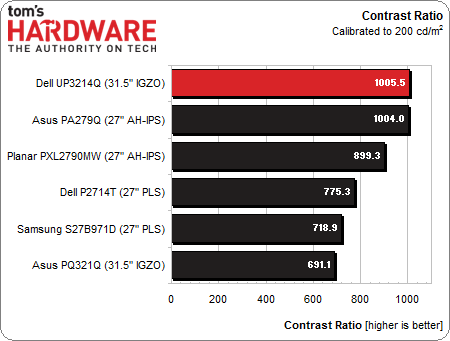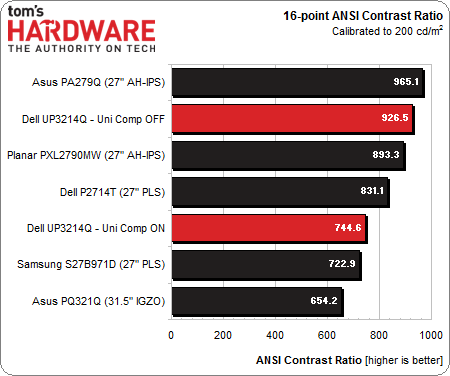Dell UltraSharp 32 Ultra HD Monitor Review: UP3214Q At $3500
Results: Brightness And Contrast
Uncalibrated
Before calibrating any panel, we measure zero and 100 percent signals at both ends of the brightness control range. This shows us how contrast is affected at the extremes of a monitor's luminance capability. We do not increase the contrast control past the clipping point. While doing this would increase a monitor’s light output, the brightest signal levels would not be visible, resulting in crushed highlight detail. Our numbers show the maximum light level possible with no clipping of the signal.
Our comparison group is the last six monitors reviewed at Tom’s, including Asus' PQ321Q Ultra HD screen. Before we move on, all of the luminance measurements are taken with Uniformity Compensation turned off, except where noted. When it’s turned on, the monitor’s dynamic range is reduced by about 25 percent, mainly due to a higher black level.
While the UP32314Q isn’t quite as bright as Asus’ PQ321Q, it has more than enough light output for any productivity, graphics, or gaming application. While you can reach Dell’s 350 cd/m2 spec by upping the contrast control, this is at the expense of crushed highlight detail and a slightly green tint in the brightest whites.
The maximum black level runs mid-pack in our comparison group.
For a monitor with its backlight turned all the way up, this is decent performance. If you need to run your display this bright, you’ll need the higher black level to discern shadow detail in a well-lit work environment.
The resulting contrast ratio is pretty solid.
Only half of the monitors we’ve reviewed in the past year can top 1000 to 1 at maximum output. Our measured result means you’ll see an excellent image with plenty of depth and dimension, even if your work environment demands a high brightness setting.
Get Tom's Hardware's best news and in-depth reviews, straight to your inbox.
We believe 50 cd/m2 is a practical minimum standard for screen brightness. Any lower and you risk eyestrain and fatigue. Some monitors, like the Dell UP3214Q, measure under that level. We recorded a minimum white level of 33.6211 cd/m2 with the backlight turned all the way down, which is a bit too dim for practical use. Raising the brightness setting to eight gets you 50 cd/m2.
The minimum black level, however, is quite good.
A reading of .0346 cd/m2 is very low. At that level, the monitor looks like it’s powered off. Even when you raise the output to 50 cd/m2, the black level is an excellent .0512 cd/m2, yielding one of the better results we’ve recorded to date.
Here are the contrast values.
We’re starting to see more consistent contrast performance from the latest displays, which means their image looks the same no matter what output level you choose. Most monitors demonstrate varying contrast when the backlight level changes. Needless to say, this trend is a very good thing!
After Calibration
Since we consider 200 cd/m2 to be an ideal point for peak output, we calibrate all of our test monitors to that value. In a room with some ambient light (like an office), this brightness level provides a sharp, punchy image with maximum detail and minimum eye fatigue. It's also the sweet spot for gamma and grayscale tracking, which we'll look at on the next page. In a darkened room, many professionals prefer a 120 cd/m2 calibration, though we find that it makes little to no difference in the calibrated black level and contrast measurements.
The calibrated black level is still nice and low. Remember that the Uniformity Compensation is turned off for these tests. Turning it on boosts the black level about 25 percent. We’ll talk more about this on page nine. Bottom line: using the compensation improves uniformity slightly, but reduces contrast. We think it’s better to leave it off.
Here are the final calibrated contrast numbers.
The calibrated contrast remains very consistent at 1005.5 to 1; again, an excellent performance. And there is no tradeoff in dynamic range when calibrating the UP3214Q. Some monitors take a hit in contrast to achieve their best color and grayscale accuracy.
ANSI Contrast Ratio
Another important measure of contrast is ANSI. To perform this test, a checkerboard pattern of sixteen zero and 100 percent squares is measured, giving us a more real-world result than on/off measurements because it tests a display’s ability to simultaneously maintain both low black and full white levels, factoring in screen uniformity as well. The average of the eight full-white measurements is divided by the average of the eight full-black measurements to arrive at the ANSI result.
We can finally quantify the impact of Uniformity Compensation. While screen uniformity is improved, overall contrast drops by 25 percent. We think the screen looks quite good in its native state without help.
Current page: Results: Brightness And Contrast
Prev Page Measurement And Calibration Methodology: How We Test Next Page Results: Grayscale Tracking And Gamma Response
Christian Eberle is a Contributing Editor for Tom's Hardware US. He's a veteran reviewer of A/V equipment, specializing in monitors. Christian began his obsession with tech when he built his first PC in 1991, a 286 running DOS 3.0 at a blazing 12MHz. In 2006, he undertook training from the Imaging Science Foundation in video calibration and testing and thus started a passion for precise imaging that persists to this day. He is also a professional musician with a degree from the New England Conservatory as a classical bassoonist which he used to good effect as a performer with the West Point Army Band from 1987 to 2013. He enjoys watching movies and listening to high-end audio in his custom-built home theater and can be seen riding trails near his home on a race-ready ICE VTX recumbent trike. Christian enjoys the endless summer in Florida where he lives with his wife and Chihuahua and plays with orchestras around the state.
-
ubercake What I always find entertaining is how these monitor manufacturers will only back their $500+ (in this case $2000+) products for a maximum of 3 years, but my $250 power supply has a 7-year warranty and my $200 SSD has a 5-year warranty.Reply -
s3anister Reply
Yes, but you miss the point.12831333 said:It's so expensive that I could buy more than twenty 1080p monitors.
This is a reasonable expectation, with economies of scale the average consumer will eventually be able to buy a 4K display for $300-$500 USD.12831370 said:I wish in 3 years the price of 4k monitors would come to $300.
Agreed. I've owned a few Dell Ultrasharp monitors and have always been surprised at the short length of warranty compared to what I get from other premium components. Sadly the entire display industry is like this in terms of warranty coverage.12831456 said:What I always find entertaining is how these monitor manufacturers will only back their $500+ (in this case $2000+) products for a maximum of 3 years, but my $250 power supply has a 7-year warranty and my $200 SSD has a 5-year warranty.
You also miss the point. I assume you didn't even read the article.12831763 said:Unacceptible input lag, display not suitable for gaming.
Anyway, great article. I was hoping TH would get around do doing a proper review of this monitor as I'm expecting it to be the benchmark for future 4K panels. -
tttttc "The company also introduced a budget-oriented 28-inch model as well, the P2815Q. Gamers might favor it more, since it's a $700 screen with a faster-responding TN panel."P2815Q has only a refresh rate of 30Hz... gamers might not favor it more...Reply -
ceberle Reply12833028 said:"The company also introduced a budget-oriented 28-inch model as well, the P2815Q. Gamers might favor it more, since it's a $700 screen with a faster-responding TN panel."P2815Q has only a refresh rate of 30Hz... gamers might not favor it more...
We hope to test the P2815Q very soon. In the meantime, we have the UP2414Q in the lab now. This is a 24-inch IPS screen for around $1200.
-Christian- -
Tanquen Why is the bezel so F-ing big? When are desktop monitors (that weight less than a TV and people actually put two or more next to each other) going to have slim or nonexistent bezels?Reply
$3500 16:9?????? Good grief! -
burmese_dude "There’s no question that 4K is here."Good. Cuz I was questioning before I read that. Now I won't question anymore.Reply
